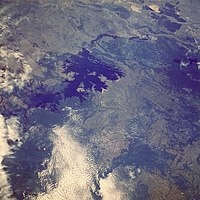Caroní River
| Caroní River | |
|---|---|
 | |
 | |
| Physical characteristics | |
| Mouth | Orinoco River in Ciudad Guayana |
The Caroni River is the second most important river of Venezuela, the second in flow, and one of the longest, 952 km from the Tepui Kuquenan, where she originates with the same name Kuquenan, up to its confluence with the River Orinoco to which basin she belongs. She gets the name "Caroni" starting from the confluence of the Kuquenan with the Yuruani, at 182 km from the source of the Kuquenan and 770 km from her discharge in the Orinoco. The meeting takes place in the south of Venezuela, in the Bolivar State, being the most important tributary of the Orinoco, mostly because of her high discharge rate. The higher basin of the Caroni is situated in the Gran Sabana (Canaima National Park) close to the border with Brazil.
Hydraulic regime
The Caroni is one of the rivers with the highest discharge rates in the world, with respect to the area of her basin. Her average discharge is 4.850 m3/s, with variations caused by the wet/dry seasons. Her average maximum discharge is 6.260m3/s and the average minimum is 3.570 m3/s. Among the historic extremes are 17.576 m3/s. The Caroni supplies 15,5% of the discharge of the Orinoco river. One of the characteristics of her water is the dark color, caused by the high amount of humic acids due to the incomplete decomposition of the phenol content of the vegetation. The Caroni therefore belongs to the blackwater rivers, as does the Negro River, or Rio Negro in Brazil, Venezuela and Colombia. In the late 1940s Diamonds were found in the Caroni basin near the famous Lost World Region which then was accessible due to aircraft and four wheel drive vehicles.[1]
The Basin of the Caroni
The Caroni basin covers an area of 95.000 km2 and is part of the Orinoco basin, the most important river of Venezuela. This means for the two big rivers that they have very similar hydro graphic characteristics. The Caroni itself and its tributary the Paragua are rivers with a staircase, in the sense that many falls and rapids are alternated with stretches with gentle slopes, with many meanders and oxbow lakes (naturally cut off meanders). Among the most important falls of these rivers and their tributaries may be mentioned the Angel Falls, with the highest free fall of the world (almost 1.000 m) and the Cuquenan Falls, the tenth on the world scale with (610 m free fall, and many others with less height but with a high volume of water, like the Aponwao Falls and the Caruay Falls and rivers with these names: the Toron River, the Eutobarima River, the falls of the Llovizna River and the Cachamay River, these last three in the Caroni itself and the last just before her discharge into the Orinoco.
Hydroelectric power

Because of its high discharge rate, with a yearly average of 4.850 m3/s and her steep slope, the Caroni ideally suited for the generation of hydroelectric energy with four plants in her course (Macagua I, II and III), near her mouth, the Caruachi, some 30 km aback, and lastly the plant of Guri, in the gut of Necoima or Necuima, some 80 km from Puerto Ordaz. This plant has its reservoir, with an area of 4000km2, in the middle of the river, and has a power of 10.000MW, and is now the third biggest in the world, after the Three Gorges dam in China (22.500 MW) and the Itaipu Dam in Paraguay and Brazil (14.000 MW)
National Parks
In the high basin of the rivers that form the Caroni (Aponguao, Cuquenán and Yuruaní) the Gran Sabana unfolds itself, partly belonging to the Canaima National Park.
Tourism
The basin of the Caroni is one of the most spectacular and beautiful of the world, ideal for adventure tourism: a landscape of forests and savannah, innumerable waterfalls and cataracts, deep canyons and high plateaux, fast running streams with very clean water (darkly tinted, almost black when deep, blackwater river, beeches with pink sand, etc. Among the most notable of the basin of the Caroni, speaking for tourists, are the waterfalls of the Aponguao, of the Kama (Kama Meru in the Caribbean language) pemon, Eutobarima (in the Caroni itself, although not easily accessible), the lake and the plant of Guri, the parks of the waterfall and of the gorge of Kavak, the table mountains(tepuis) of the Roraima and the Kuquenan.
References
- ^ "Treasure Hunt In A Lost World." Popular Mechanics, September 1950, pp. 73-79.

